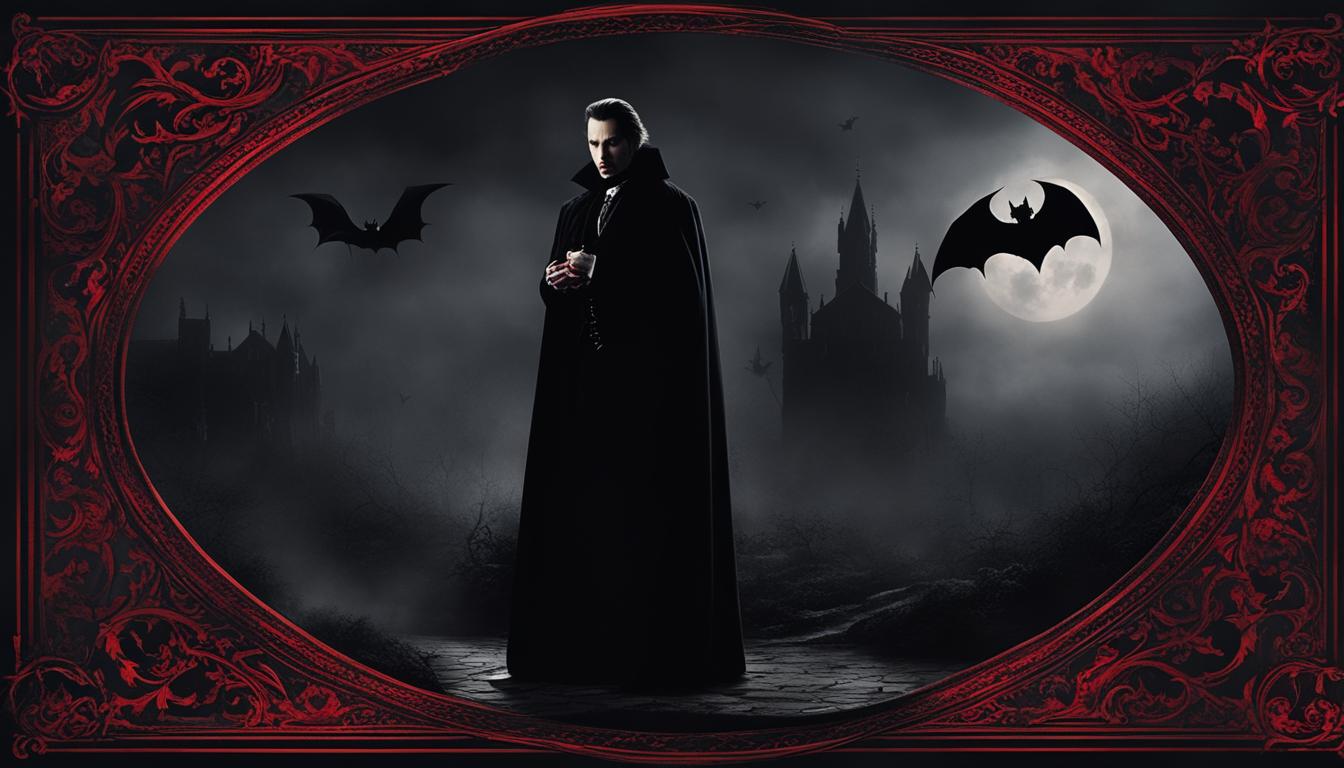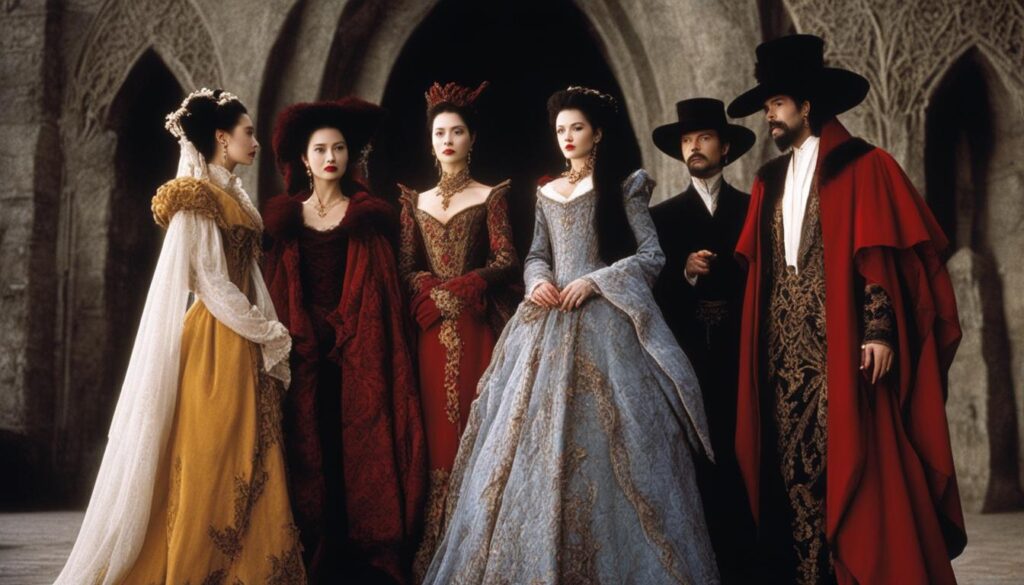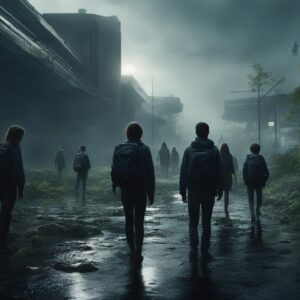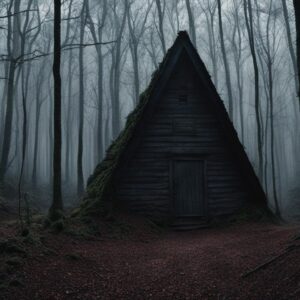Welcome to my exploration of Bram Stoker’s Dracula (1992), the mesmerizing film directed by Francis Ford Coppola. This gothic horror masterpiece, featuring a stellar cast including Gary Oldman, Keanu Reeves, and Winona Ryder, takes audiences on a captivating journey into the world of vampire lore. With its haunting visuals, intense romance, and faithful adaptation of Stoker’s novel, Bram Stoker’s Dracula offers an unforgettable cinematic experience.
Key Takeaways:
- Bram Stoker’s Dracula (1992) is a visually stunning adaptation of the classic horror novel, staying true to the original source material.
- The film incorporates elements of gothic romance, capturing the tragic love story between Count Dracula and Mina Murray.
- Eiko Ishioka’s elaborate costume design adds a surreal and symbolic dimension to the characters and narrative.
- The collaboration between Francis Ford Coppola and Ishioka creates a unique visual language that pays homage to gothic horror and early cinema.
- Bram Stoker’s Dracula has left an enduring legacy as a cinematic masterpiece and continues to inspire filmmakers and artists.
The Genesis of Bram Stoker’s Dracula
When it comes to the origins of Bram Stoker’s Dracula (1992), it all began with Winona Ryder. After dropping out of another film project, Ryder brought the screenplay for the adaptation by James V. Hart to the attention of director Francis Ford Coppola. Ryder was eager to bring Stoker’s Victorian horror novel to life on the big screen and saw Coppola as the perfect director for the project. Intrigued by his childhood fascination with Dracula, Coppola agreed to take on the ambitious task of bringing the iconic vampire to life.
In staying true to Stoker’s original source material, Coppola carefully crafted the plot structure and characters of Bram Stoker’s Dracula. The film’s narrative closely follows the events of the novel, incorporating elements like epistolary framing through the use of characters’ diaries and journals. This fidelity to Stoker’s work extends to the inclusion of all the fearless vampire hunters, such as Jonathan Harker, Professor Van Helsing, and Quincey P. Morris, who are seldom portrayed in other adaptations.
However, what sets Bram Stoker’s Dracula apart is the emphasis on the gothic romance between Count Dracula and Mina Murray Harker, played by Gary Oldman and Winona Ryder, respectively. This element adds an extra layer of complexity and tragedy to the story, as Dracula’s pursuit of Mina is driven by his desire to be with his lost love once again. The film’s adaptation of Dracula’s tragic past and his unrequited love adds a new dimension to the character, making him a more sympathetic and multi-dimensional figure.
| Key Points |
|---|
| Winona Ryder brought the screenplay to Francis Ford Coppola, who was intrigued by the project. |
| The film closely follows the plot structure and characters of Bram Stoker’s original novel. |
| Bram Stoker’s Dracula focuses on the gothic romance between Count Dracula and Mina Murray Harker. |
“I was immediately struck by the tragic romance in Bram Stoker’s novel and saw it as an opportunity to explore the depths of Dracula’s character. Winona Ryder’s enthusiasm for the project only fueled my passion for bringing this gothic tale to life.” – Francis Ford Coppola
The Historical Background of Bram Stoker’s Dracula
Bram Stoker’s Dracula (1992) draws inspiration from the historical figure of Vlad III, also known as Vlad the Impaler. While not directly related to Stoker’s novel, the film incorporates elements from Vlad’s history to add depth and tragedy to Count Dracula’s character. In the movie, Dracula’s wife, Princess Elisabeta, commits suicide by throwing herself into a river, believing she is about to be captured by the Turks. This event serves as an operatic backdrop for Dracula’s transformation into a vampire. When Elisabeta dies and is consigned to Hell, Dracula sells his soul to Satan and becomes undead. This historical inspiration lends complexity and a more sympathetic portrayal to Gary Oldman’s performance as Dracula, as he seeks to reunite with his lost love in the form of Mina Murray.
The Historical Background of Bram Stoker’s Dracula
The historical inspiration for Bram Stoker’s Dracula is found in the figure of Vlad III, also known as Vlad the Impaler. In the film, the character of Dracula is linked to Vlad through a tragic event involving his wife, Princess Elisabeta. Elisabeta commits suicide, believing she is about to be captured by the Turks, and Dracula sells his soul to Satan to become a vampire and seek eternal love. This historical context adds depth and tragedy to the character of Dracula and provides a historical anchor for his transformation.
While Bram Stoker’s Dracula takes creative liberties with history, the incorporation of Vlad III’s story serves as a catalyst for the narrative and offers a deeper understanding of Count Dracula’s motivations. This historical background adds layers of complexity to the film, elevating it beyond a traditional vampire tale and creating a more nuanced portrayal of the iconic character.
| Historical Inspiration | Film Adaptation |
|---|---|
| Vlad III, also known as Vlad the Impaler | Incorporated elements from Vlad’s history into the story |
| Princess Elisabeta’s suicide | Transformed into an operatic backdrop for Dracula’s transformation |
| Dracula’s selling his soul to Satan | Added depth and tragedy to Gary Oldman’s portrayal of the character |
The historical background of Bram Stoker’s Dracula draws from the figure of Vlad III, also known as Vlad the Impaler. Princess Elisabeta’s suicide serves as an operatic backdrop for Dracula’s transformation, adding depth and complexity to the character. The film creatively weaves historical inspiration into its narrative, resulting in a more nuanced and compelling portrayal of the iconic vampire.
“The historical context of Vlad III’s story provides a rich foundation for the character of Dracula in Bram Stoker’s adaptation. The tragedy of Princess Elisabeta’s suicide and Dracula’s subsequent transformation adds layers of depth and complexity to Gary Oldman’s performance. It is this historical background that gives the film a unique twist and elevates it beyond a traditional vampire tale.” – Film Critic
Eiko Ishioka’s Exquisite Costumes in Bram Stoker’s Dracula
One of the standout aspects of Bram Stoker’s Dracula is the exquisite costume design by Eiko Ishioka. Her meticulous attention to detail and artistic vision resulted in a visually stunning portrayal of the characters and the gothic fantasy world they inhabit. Ishioka’s talent and creativity earned her an Academy Award for Best Costume Design, and it’s no wonder why. Her costumes not only enhance the narrative but also serve as works of art in their own right.
From the nightmarish armor worn by Count Dracula in the film’s prologue to the iconic wedding gown of Lucy Westerna, Ishioka’s designs are intricate, elaborate, and visually striking. Each costume reflects the personality and journey of the character, immersing the audience in the story and adding depth to their portrayal. The attention to detail is evident in the lace ruffs, intricate embroidery, and dramatic silhouettes that bring these characters to life.
| Character | Description |
|---|---|
| Count Dracula | Wears nightmarish armor that symbolizes his transformation into an undead being |
| Mina Murray | Her costumes reflect her Victorian sensibilities and the constraints she faces in society |
| Lucy Westerna | Her wedding gown showcases lace ruffs that symbolize her transformation into a vampire |
“Eiko Ishioka’s costume designs in Bram Stoker’s Dracula are nothing short of extraordinary. They not only enhance the storytelling but also serve as works of art. Her attention to detail and ability to capture the essence of each character through their costumes is truly remarkable.” – Francis Ford Coppola
Eiko Ishioka’s contribution to Bram Stoker’s Dracula goes beyond costume design; her work adds depth, beauty, and visual storytelling to the film. Each costume is a testament to her artistry and creative genius. From the Academy Award-winning designs to the intricate details that bring the characters to life, Ishioka’s costumes are a vital component of the film’s gothic fantasy aesthetic and continue to be celebrated for their timeless beauty.
The Collaboration between Coppola and Ishioka
When it comes to the creation of the stunning costumes in Bram Stoker’s Dracula (1992), the collaboration between director Francis Ford Coppola and costume designer Eiko Ishioka played a crucial role. Building on their previous projects, this creative partnership brought forth a visual feast that perfectly captured the gothic romance and horror of Stoker’s novel.
Francis Ford Coppola, known for his meticulous attention to detail, turned to Eiko Ishioka to bring his vision to life. Ishioka’s talent as a designer was already well-established, and she had previously collaborated with Coppola on films like Apocalypse Now. Together, they aimed to create costumes that would dominate the sets, enhancing the visual storytelling. While this original concept couldn’t be fully realized due to studio constraints, Ishioka’s designs still took center stage, shaping the aesthetic of the film and enriching the performances of the actors.
“The collaboration between Coppola and Ishioka brought forth a visual feast that perfectly captured the gothic romance and horror of Stoker’s novel.”
Ishioka’s exquisite costume designs showcased her artistic brilliance. Her attention to detail and ability to convey meaning through her creations added depth to the characters and the narrative. Each costume reflected the personalities of the characters, as well as the constraints they faced in Victorian society. From the nightmarish armor worn by Dracula to the iconic wedding gown of Lucy Westerna, Ishioka’s costumes not only served as visual spectacle but also contributed to the overall storytelling of the film.
The collaboration between Coppola and Ishioka in Bram Stoker’s Dracula highlights the power of creative partnerships in filmmaking. Their combined talents brought forth a visually stunning portrayal of Stoker’s novel, elevating it to a new level of artistry and cementing its status as a timeless classic.
Table: Costume Highlights in Bram Stoker’s Dracula
| Character | Costume Description |
|---|---|
| Count Dracula (Gary Oldman) | A nightmarish armor in the prologue represents his transformation into an undead being. |
| Mina Murray (Winona Ryder) | A blend of innocence and sensuality, reflecting her role as the object of Dracula’s affection. |
| Lucy Westerna (Sadie Frost) | An extravagant wedding gown adorned with lace ruffs that symbolize her transformation into a vampire. |
| Professor Van Helsing (Anthony Hopkins) | A traditional yet eccentric attire, portraying his knowledge and expertise in vampire hunting. |
The Symbolism in Ishioka’s Costumes
Eiko Ishioka’s costumes in Bram Stoker’s Dracula go beyond their aesthetic appeal to convey deeper symbolism tied to the characters and the narrative. The armor worn by Dracula in the prologue represents his transformation into an undead being, while the wedding gown of Lucy Westerna is a spectacular display of lace ruffs that symbolize her transformation into a vampire. The costumes of Mina Murray and the other characters reflect their personalities and the constraints they face in Victorian society. Ishioka’s attention to detail and her ability to convey meaning through her designs contribute to the richness of the film’s visual storytelling.
“I wanted to create something that wasn’t just a costume, but something that would tell a story and reveal the inner world of the character.” -Eiko Ishioka
The symbolism in Ishioka’s costumes adds depth and nuance to the characters’ arcs. By visually representing their transformations and inner turmoil, the costumes become integral to the storytelling. For example, Mina Murray’s costumes evolve from modest and restrictive to more revealing and empowered as she becomes entangled in Dracula’s web. This progression reflects her journey from innocence to temptation and ultimately her agency in the face of darkness. Similarly, the gory and grotesque aspects of Dracula’s armor contrast with the elegance and romanticism of his later costumes, encapsulating the duality of his nature as both monster and lover.
Furthermore, the costumes serve as a reflection of the film’s themes and motifs. The opulent and ornate designs embody the gothic romance that permeates the story, while the use of dark, rich colors emphasizes the film’s macabre atmosphere. The costumes become visual representations of the characters’ desires, fears, and struggles, enhancing the emotional connection between the audience and the narrative.
The Symbolism in Ishioka’s Costumes Table:
| Character | Costume | Symbolism |
|---|---|---|
| Dracula | Armor in the prologue | Transformation into an undead being |
| Lucy Westerna | Wedding gown with lace ruffs | Transformation into a vampire |
| Mina Murray | Evolving costumes | Journey from innocence to empowerment |
| Others | Reflective costumes | Personality and societal constraints |
The Stylized Vision of Bram Stoker’s Dracula
Francis Ford Coppola’s vision for Bram Stoker’s Dracula was to create a visually striking film that paid homage to the gothic horror genre and the silent films of the past. Drawing inspiration from German expressionism, Coppola crafted a unique visual style that captivates audiences to this day.
The film features intricate set designs, with elaborate costumes and carefully crafted lighting, creating a sense of grandeur and foreboding. The use of forced perspective and theatrical lighting adds depth and creates a haunting atmosphere. The deliberate choice to incorporate elements reminiscent of silent films adds a timeless quality to the production, making it both innovative and nostalgic.
Through his collaboration with cinematographer Michael Ballhaus, Coppola brought his vision to life, capturing the eerie beauty and gothic aesthetic of the story. The film’s stunning cinematography, combined with its meticulous attention to detail, transports viewers to a world where darkness and romance intertwine.
Table: Visual Elements in Bram Stoker’s Dracula
| Visual Element | Description |
|---|---|
| Forced perspective | Creates a sense of depth and dimension, making scenes visually striking |
| Theatrical lighting | Enhances the dramatic effect and adds to the gothic atmosphere |
| Intricate set designs | Transport viewers to a world of gothic romance and horror |
| Elegant costumes | Reflect the characters’ personalities and contribute to the visual spectacle |
Coppola’s stylized vision in Bram Stoker’s Dracula creates a mesmerizing visual experience that immerses viewers in a world of gothic horror and romance. The film’s unique blend of visual elements, inspired by German expressionism and silent film techniques, sets it apart and solidifies its place as a timeless classic.
The Stellar Cast of Bram Stoker’s Dracula
One of the highlights of Bram Stoker’s Dracula is its stellar ensemble cast, led by acclaimed actors who deliver remarkable performances that bring the characters to life. Gary Oldman’s portrayal of the infamous Count Dracula is a radical reinvention that pays homage to the character’s iconic status while adding depth and complexity to his portrayal. Oldman’s ability to seamlessly transition between the seductive and terrifying facets of Dracula’s nature captivates audiences, making him a memorable and haunting presence throughout the film.
“I wanted to create a Dracula that is both monstrous and sympathetic, a true embodiment of the tortured soul,” says Francis Ford Coppola, the film’s director.
Winona Ryder shines as Mina Murray, capturing the vulnerability and allure of the character with her captivating performance. Ryder effortlessly portrays Mina’s emotional journey, from a naive young woman to a strong and determined fighter against the forces of darkness. Anthony Hopkins brings his signature intensity to the role of Professor Abraham Van Helsing, infusing the character with an Old World flair and a relentless determination to rid the world of the vampire menace.
While the cast is filled with standout performances, Keanu Reeves’s portrayal of Jonathan Harker has faced criticism for his attempt at an English accent and lack of emotional depth. Despite this, the chemistry among the cast members and their commitment to their roles elevates Bram Stoker’s Dracula into a mesmerizing cinematic experience.
| Cast Member | Character | Performance |
|---|---|---|
| Gary Oldman | Count Dracula | A radical reinvention that combines both monstrous and sympathetic elements, captivating audiences. |
| Winona Ryder | Mina Murray | Effortlessly captures the vulnerability and allure of the character, taking the audience on a compelling emotional journey. |
| Anthony Hopkins | Professor Abraham Van Helsing | Brings his signature intensity to the role, infusing the character with an Old World flair and relentless determination. |
| Keanu Reeves | Jonathan Harker | While facing criticism for his English accent and lack of emotional depth, Reeves’s performance contributes to the chemistry and dynamics of the cast. |
The Visual Mastery of Practical Effects in Bram Stoker’s Dracula
When it comes to creating visual magic on the big screen, Bram Stoker’s Dracula (1992) stands as a prime example of the power of practical effects. Instead of relying on modern computer-generated imagery, the film utilizes various tricks and techniques to achieve stunning visual results. This dedication to practical effects adds a tangible and timeless quality to the film, ensuring that its visuals remain captivating and impressive even decades after its release.
One of the key figures behind the visual mastery of practical effects in Bram Stoker’s Dracula is Roman Coppola, who oversaw their execution. By employing techniques such as forced perspective, miniatures, and multiple exposures, the film creates the illusion of Dracula’s transformative powers and otherworldly elements. These practical effects not only immerse the audience in the fantastical world of the vampire but also enhance the storytelling by bringing the supernatural to life in a tangible way.
“The use of practical effects in Bram Stoker’s Dracula adds a level of authenticity and craftsmanship to the film that is truly remarkable. It’s the magic of movie-making at its finest.” – Roman Coppola
Table:
| Practical Effects Techniques | Description |
|---|---|
| Forced Perspective | Creating the illusion of depth and scale by manipulating the perception of distance between objects. |
| Miniatures | Creating small-scale models of sets or objects to enhance the realism of the film. |
| Multiple Exposures | Superimposing multiple images onto a single frame, allowing for the blending of different elements and the creation of ghostly or ethereal effects. |
Through the meticulous execution of these practical effects, Bram Stoker’s Dracula transports viewers into a mesmerizing world of visual enchantment. The attention to detail and the commitment to practicality in the film’s visual effects showcase the artistry and craftsmanship required to bring the story to life. Roman Coppola’s expertise in overseeing these effects adds a touch of magic to the film, making Bram Stoker’s Dracula an enduring testament to the power of practical effects in cinema.
The Stunning Cinematography of Bram Stoker’s Dracula
One of the most striking aspects of Bram Stoker’s Dracula (1992) is its breathtaking cinematography, expertly executed by renowned cinematographer Michael Ballhaus. Ballhaus’s visual mastery brings the gothic horror tale to life, creating a mesmerizing cinematic experience that leaves a lasting impact.
“The cinematography draws inspiration from German Expressionism, bringing a heightened sense of drama and visual storytelling to the screen.”
Ballhaus’s use of chiaroscuro, the interplay of light and shadow, creates a visually captivating atmosphere that underscores the eerie nature of the story. The calculated placement of light sources and the deliberate framing of each scene heighten the tension and suspense, immersing the audience in the dark and foreboding world of Dracula.
The influence of German Expressionism is evident in Ballhaus’s cinematography, as he employs techniques reminiscent of the influential movement. The use of stark contrasts, dramatic angles, and distorted perspectives adds depth and symbolism to the visuals, enhancing the film’s overall gothic aesthetic.
The cinematography in Bram Stoker’s Dracula is a testament to Michael Ballhaus’s exceptional skill and artistic vision. His meticulous attention to detail and innovative approach to lighting and composition elevate every frame, making the film a true feast for the eyes.
The Visual Mastery of Chiaroscuro
Chiaroscuro is a prominent technique used by Michael Ballhaus in Bram Stoker’s Dracula to create a visually striking contrast between light and shadow. This deliberate interplay emphasizes the dramatic elements of the story, heightening the gothic atmosphere and intensifying the suspense.
Through careful lighting design and precise positioning of actors and props, Ballhaus creates a sense of depth and dimension in each scene. The use of shadows not only adds visual interest but also conveys the internal struggles and darkness within the characters themselves.
“Chiaroscuro adds depth and symbolism to the visuals, enhancing the film’s overall gothic aesthetic.”
The contrast between light and shadow is particularly evident in iconic moments, such as Dracula’s shadow creeping up the staircase or the silhouette of the vampire hunters against the moonlit sky. These stunning visual compositions serve to heighten the emotional impact and immerse the audience in the haunting world of the film.
German Expressionism and Visual Storytelling
The influence of German Expressionism in Bram Stoker’s Dracula’s cinematography is a testament to the power of visual storytelling. Ballhaus’s decision to draw inspiration from this influential art movement adds a layer of depth and symbolism to the film.
The exaggerated angles, distorted perspectives, and unconventional use of light and shadow create a sense of unease and foreboding, aligning with the gothic themes of the narrative. The stylized visuals not only enhance the overall atmosphere but also serve to convey the internal struggles and torments of the characters.
“German Expressionism’s techniques bring a heightened sense of drama and visual storytelling to the screen.”
The visual mastery of Ballhaus’s cinematography, combined with the influence of German Expressionism, ensures that Bram Stoker’s Dracula remains a visually stunning and evocative cinematic experience, capturing the essence of the gothic horror genre.
| Aspect | Description |
|---|---|
| Chiaroscuro | The deliberate use of light and shadow to create contrast and enhance the gothic atmosphere of the film. |
| German Expressionism | Incorporating techniques from the influential art movement to create a sense of unease and foreboding. |
| Visual storytelling | Using visuals to convey the internal struggles and torments of the characters and enhance the narrative’s emotional impact. |
The Captivating Sound Design and Score of Bram Stoker’s Dracula
In Bram Stoker’s Dracula (1992), the sound design and score play a crucial role in creating an immersive and atmospheric experience for the audience. The film’s sound design, crafted with meticulous attention to detail, enhances the eerie and unsettling nature of the story. The haunting whispers, screams, and voices that permeate the soundtrack add layers of uneasiness and intensify the sense of dread. The atmospheric sound design brings the world of Dracula to life, immersing viewers in a sonic landscape that heightens the emotional impact of the film.
The use of sound in Bram Stoker’s Dracula is a testament to the craftsmanship behind the film. As Wojciech Kilar’s powerful gothic score swells in the background, it perfectly captures the romantic and sinister undertones of the story. The score’s use of orchestral arrangements, combined with an otherworldly soprano voice, creates a haunting and ethereal atmosphere. Together with the intricate sound design, the score adds an additional layer of depth and complexity to the film, accentuating the inner turmoil of Count Dracula and the allure of the vampire world.
The captivating sound design and score of Bram Stoker’s Dracula contribute to the film’s immersive experience, enriching the storytelling and deepening the audience’s connection to the characters and narrative. The combination of atmospheric sound and gothic score creates a haunting and evocative backdrop that lingers in the mind long after the film ends. It is a testament to the power of sound in cinema and showcases the artistry of sound designers and composers in creating a visceral and emotionally resonant experience.
| Elements of Sound Design and Score in Bram Stoker’s Dracula | Description |
|---|---|
| Sound Effects | The use of haunting whispers, screams, and voices intensifies the sense of dread and uneasiness in the film. |
| Atmospheric Sound | The sound design creates an immersive sonic landscape that brings the world of Dracula to life, enhancing the audience’s emotional connection to the story. |
| Gothic Score | Wojciech Kilar’s powerful score captures the romantic and sinister undertones of the film, creating a haunting and ethereal atmosphere. |
| Otherworldly Soprano Voice | The inclusion of a soprano voice in the score adds an otherworldly and ethereal quality, highlighting the conflicted nature of Count Dracula. |
The sound design and score of Bram Stoker’s Dracula are integral to the film’s overall aesthetic and emotional impact. They contribute to the immersive experience, transporting viewers into the dark and seductive world of the iconic vampire. The meticulous craftsmanship in the sound design and score elevates the film, making it an unforgettable audiovisual spectacle.
Bram Stoker’s Dracula’s Enduring Legacy
Bram Stoker’s Dracula (1992) is a cinematic masterpiece that continues to captivate audiences with its visual spectacle and enduring cultural impact. This gothic horror film, directed by Francis Ford Coppola, has left an indelible mark on the genre and stands as a testament to the power of visual storytelling.
From its intricate costumes to its innovative practical effects, Bram Stoker’s Dracula showcases a meticulous attention to detail that transports viewers into the chilling world of the iconic vampire. The collaboration between Coppola and costume designer Eiko Ishioka brings the characters to life with haunting and beautiful attire, adding depth and symbolism to the narrative.
“Bram Stoker’s Dracula continues to be celebrated for its artistry, immersing audiences in the chilling world of the iconic vampire.”
the film’s stunning cinematography, helmed by Michael Ballhaus, creates a gothic aesthetic that perfectly complements the story. The use of chiaroscuro lighting and techniques inspired by German Expressionism evokes a sense of drama and heightens the film’s eerie atmosphere.
With its visual mastery and cultural impact, Bram Stoker’s Dracula has solidified its place as a timeless classic that continues to inspire filmmakers and artists today.
Conclusion
In conclusion, Bram Stoker’s Dracula (1992) directed by Francis Ford Coppola is a gothic horror vampire film that has left a lasting cultural impact. The film’s visual masterpiece, brought to life by the collaboration between Coppola and costume designer Eiko Ishioka, immerses viewers in a chilling and mesmerizing world. With its stunning visuals, innovative practical effects, and faithful adaptation of the source material, Bram Stoker’s Dracula stands as a true cinematic gem.
The gothic horror aesthetic, combined with Coppola’s meticulous attention to detail, creates an atmosphere that is both haunting and beautiful. The film’s visual prowess is further enhanced by Ishioka’s incredible costume designs, which not only add to the aesthetic appeal but also convey deeper symbolism tied to the characters and the narrative.
Bram Stoker’s Dracula continues to be celebrated as a cultural touchstone and has inspired subsequent films within the genre. Its enduring legacy as a visual masterpiece and its impact on popular culture solidify its place in cinematic history. The film remains a testament to the artistic vision of Francis Ford Coppola and Eiko Ishioka, offering an unforgettable journey into the world of one of literature’s most iconic vampires.
FAQ
What is Bram Stoker’s Dracula (1992) about?
Bram Stoker’s Dracula is a gothic horror film directed by Francis Ford Coppola. It is an adaptation of the classic vampire novel and follows the story of Count Dracula’s attempt to reunite with his lost love in Victorian England.
Who directed Bram Stoker’s Dracula?
Bram Stoker’s Dracula was directed by Francis Ford Coppola, known for his work on iconic films such as The Godfather trilogy and Apocalypse Now.
Who are the main characters in Bram Stoker’s Dracula?
The main characters in Bram Stoker’s Dracula include Count Dracula, played by Gary Oldman, Mina Murray Harker, played by Winona Ryder, and Professor Van Helsing, played by Anthony Hopkins.
Is Bram Stoker’s Dracula faithful to the original novel?
Yes, Bram Stoker’s Dracula stays true to the original source material, featuring accurate plot structure and characters. It includes all of Stoker’s vampire hunters and incorporates elements like epistolary framing with diary entries.
What is the historical background of Bram Stoker’s Dracula?
While not directly related to Bram Stoker’s novel, the film incorporates elements from the history of Vlad III, also known as Vlad the Impaler, into its storyline. This historical inspiration adds depth and tragedy to Dracula’s character.
Who designed the costumes for Bram Stoker’s Dracula?
The costumes in Bram Stoker’s Dracula were designed by Eiko Ishioka, who won an Academy Award for Best Costume Design for her work on the film.
What visual style does Bram Stoker’s Dracula employ?
Bram Stoker’s Dracula combines gothic horror with German expressionism and the techniques of silent film. The film utilizes forced perspective, theatrical lighting, and carefully designed sets to create a visually stunning and atmospheric experience.
Who are the main actors in Bram Stoker’s Dracula?
The main actors in Bram Stoker’s Dracula include Gary Oldman as Count Dracula, Winona Ryder as Mina Murray Harker, Anthony Hopkins as Professor Van Helsing, and Keanu Reeves as Jonathan Harker.
How were the visual effects in Bram Stoker’s Dracula created?
Bram Stoker’s Dracula utilized practical effects, such as forced perspective, miniatures, and multiple exposures, to achieve stunning visual results. The film chose to rely on these traditional techniques rather than modern computer-generated imagery.
Who was the cinematographer for Bram Stoker’s Dracula?
The cinematography for Bram Stoker’s Dracula was done by Michael Ballhaus, who created a visually striking aesthetic using techniques such as chiaroscuro and drawing inspiration from German Expressionism.
What is the legacy of Bram Stoker’s Dracula?
Bram Stoker’s Dracula is considered a cinematic masterpiece and a visual spectacle. Its enduring legacy lies in its impact on the gothic horror genre and its continued inspiration for filmmakers and artists.







